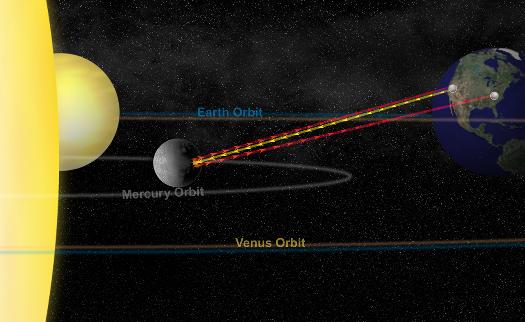Embargoed For Release: 2:00 p.m., EDT, Thursday, May 3, 2007
Contact:
Dave Finley, Public Information Officer
Socorro, NM
(505) 835-7302
dfinley@nrao.edu
Mercury's Core Molten, Radar Study Shows
Scientists using a high-precision planetary radar technique for the first time have discovered that the innermost planet Mercury probably has a molten core, resolving a mystery of more than three decades. The discovery, which used the National Science Foundation's Robert C. Byrd Green Bank Telescope in West Virginia and Arecibo Observatory in Puerto Rico, and NASA/Jet Propulsion Laboratory antennas in California, is an important step toward a better understanding of how planets form and evolve.

High-precision planetary radar technique sent signal to Mercury, received reflection. CREDIT: Bill Saxton, NRAO/AUI/NSF Click on image for high-resolution file (447 KB) |
"For a long time it was thought we'd have to land spacecraft on Mercury to learn if its core is solid or molten. Now we've answered that question using ground-based telescopes," said Jean-Luc Margot, of Cornell University, leader of the research team, which published its results in the May 4 issue of the journal Science.
Mercury is one of the least-understood of the planets in our Solar System. Its distance from the Sun is just over one-third that of the Earth, and it contains a mass just 5½ percent that of Earth. Only about half of Mercury's surface has been photographed by a spacecraft, Mariner 10, back in 1974.
Mariner 10 also discovered that Mercury has a weak magnetic field, about one percent as strong as Earth's. That discovery spurred a scientific debate about the planet's core. Scientists normally expect a rocky planet's magnetic field to be caused by an electromagnetic dynamo in a molten core. However, Mercury is so small that most scientists expected its core to have cooled and solidified long ago. Those scientists speculated that the magnetic field seen today may have been "frozen" into the planet when the core cooled.
"Whether the core is molten or solid today depends greatly on the chemical composition of the core. That chemical composition can provide important clues about the processes involved in planet formation," Margot said.
To answer the question, the scientists implemented an ingenious, high-precision technique in which they sent a powerful beam of radio waves to bounce off Mercury, then received and analyzed the reflected signal using pairs of ground-based radio telescopes. While similar radar systems have been used in the past to map planetary surfaces, this technique instead measured the rate at which Mercury spins on its axis, and did so with an unprecedented precision of one part in 100,000.
By making 21 separate observations, the research team was able to measure minute variations in the planet's spin rate. This was the key to learning whether Mercury's core is solid or molten. Using an understanding of the Sun's gravitational effect on the planet, they realized that the tiny variations in its spin rate would be twice as large if the core is liquid than they would be if Mercury has a solid core.
"The variations in Mercury's spin rate that we measured are best explained by a core that is at least partially molten. We have a 95 percent confidence level in this conclusion," Margot said.
For most of their observations, carried out from 2002-2006, the scientists transmitted a powerful radar beam from the NASA/JPL 70-meter antenna at Goldstone, California, and received the reflected signal with the Green Bank Telescope and the Goldstone antenna. For some observations, they transmitted from the Arecibo Observatory in Puerto Rico and received at Arecibo and two Goldstone antennas. They used radar signals at frequencies of 8.5 and 2.4 GHz.
To make the precision measurements of Mercury's spin rate, the geometry between the planet and the receiving antennas had to match a specific alignment. Such an alignment only occurs for about 20 seconds a day.
In addition to measuring Mercury's spin rate, their technique also made the best measurement ever of the alignment of the planet's axis of rotation. "We improved the accuracy of this measurement by 100 times, and showed that Mercury's spin axis is almost, but not exactly, perpendicular to the plane of its rotation around the Sun," Margot said.
Margot worked with Stanton Peale of the University of California, Santa Barbara, Raymond Jurgens and Martin Slade of NASA's Jet Propulsion Laboratory, and Igor Holin of the Space Research Institute in Moscow.
The National Radio Astronomy Observatory is a facility of the National Science Foundation, operated under cooperative agreement by Associated Universities, Inc. The Arecibo Observatory is part of the National Astronomy and Ionosphere Center, which is operated by Cornell University under a cooperative agreement with the NSF. Part of this work was supported by the Jet Propulsion Laboratory, operated by Caltech under contract with NASA.
Modified on Tuesday, 24-Apr-2007 17:14:30 EDT